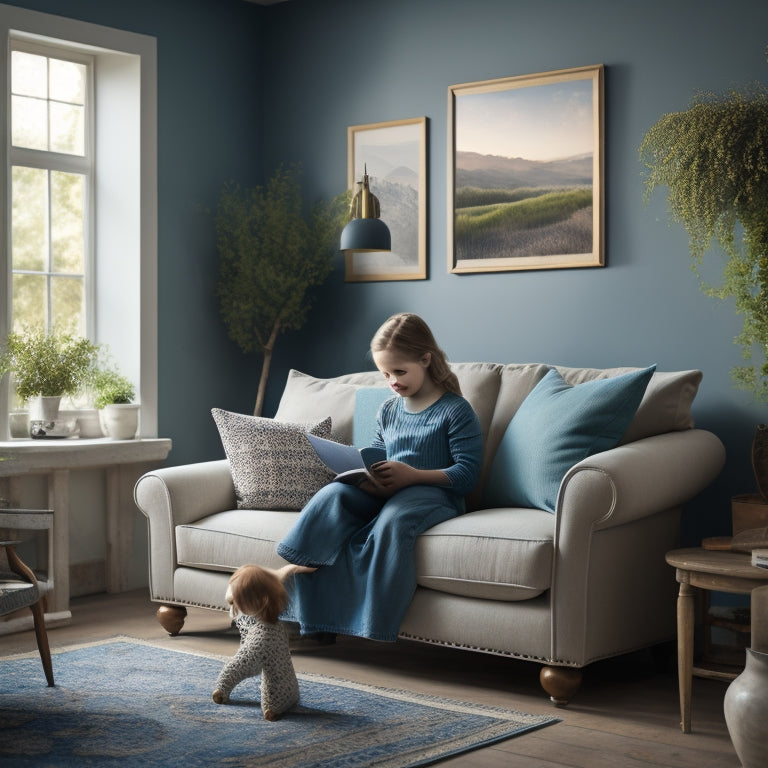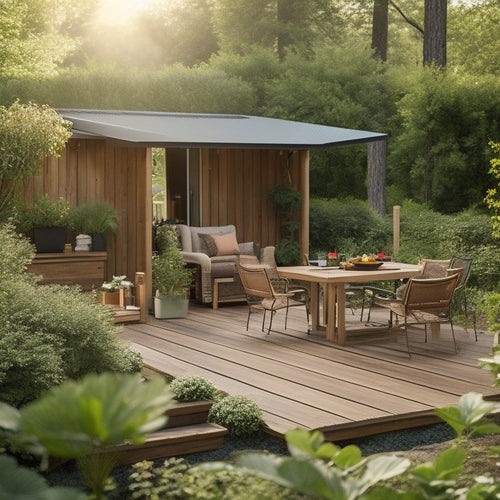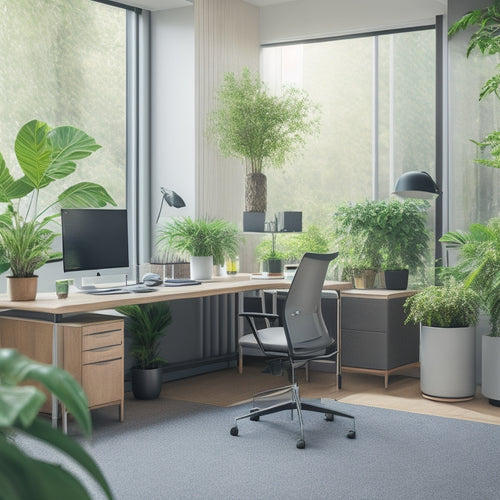
What Are the Safest Paint Choices for Your Home?
Share
When choosing the safest paint for your home, consider natural and eco-friendly options that prioritize your health and the environment. Look for brands that use plant-based pigments, natural colorants, and sustainable sources, ensuring low to zero VOCs and non-toxic formulations. For sensitive environments like nurseries, opt for baby-safe ingredients and certifications like Greenguard Gold. As you investigate your options, you'll find a range of low-VOC and zero-VOC paints that promote healthier indoor air quality and meet stringent environmental standards. By understanding what makes a paint safe, you'll be able to make an informed decision that benefits both you and the planet, and there's more to uncover.
Key Takeaways
- Opt for natural and eco-friendly paints that use plant-based pigments and are free from harsh chemicals and VOCs.
- Look for certifications like Greenguard Gold or CARB Compliance to ensure the paint meets stringent environmental and health standards.
- Choose non-toxic and biodegradable paints that prioritize baby-safe ingredients, especially for nurseries and children's spaces.
- Consider DIY natural paint recipes using natural dyes and binders for a customized, sustainable, and safe painting solution.
- Prioritize paints with low or zero VOC levels, as they reduce indoor air pollution and minimize health risks.
Natural Paint Options Explained
About 80% of paints on the market today are made from synthetic materials, which can release harmful volatile organic compounds (VOCs) into the air.
You don't have to settle for these toxic options, though. Natural paint options are made from natural colorants and plant-based pigments, offering a safer alternative for your home.
With the increasing adoption of electric vehicles, it's crucial to reflect on the environmental impact of our daily choices, including the paint we use fast charging infrastructure.
These eco-friendly paints are derived from natural sources such as clay, silica, and plant extracts. They provide a non-toxic and biodegradable way to add color to your walls.
Natural paint options may cost a bit more, but they're a worthwhile investment for your health and the environment.
Low VOC Paint Benefits
Your decision to opt for low VOC paints yields numerous benefits for your health and the environment. By choosing low VOC paints, you reduce your exposure to harsh chemicals and VOCs (volatile organic compounds) that can trigger respiratory issues, allergic reactions, and other health problems. Low VOC paints also have a low odor, making them ideal for indoor painting projects.
| Benefits | Description |
|---|---|
| Health Benefits | Reduces exposure to harsh chemicals and VOCs, minimizing health risks |
| Low Odor | Pleasant painting experience with minimal disruption |
| Environmental Benefits | Low VOCs reduce air pollution and contribute to a healthier environment |
| Better Indoor Air Quality | Improves indoor air quality, essential for people with respiratory issues |
| Compliance | Meets or exceeds environmental regulations and standards |
Eco-Friendly Paint Brands Compared
Now that you've made the decision to opt for low VOC paints, it's time to examine the various eco-friendly paint brands available in the market.
You'll find brands that prioritize sustainable sourcing, using natural resources and minimizing waste. Look for eco-friendly innovations like plant-based formulas and recyclable packaging.
As you investigate, consider the importance of renewable energy sources in powering eco-friendly infrastructure, such as green energy electric vehicle charging stations.
Some popular brands include Ecos, Anna Sova, and Yolo Colorhouse, which offer a range of colors and finishes while maintaining a commitment to environmental responsibility.
When comparing brands, consider factors like VOC levels, ingredient transparency, and third-party certifications like Greenguard Gold.
Non-Toxic Paint for Nurseries
When selecting a non-toxic paint for your baby's nursery, you're likely prioritizing baby-safe ingredients that won't release harmful chemicals into the air.
Zero VOC (volatile organic compound) options are a great place to start, as they minimize indoor air pollution and create a healthier environment for your little one.
Additionally, considering the electrical infrastructure and grid capacity upgrades electrical infrastructure upgrades in your home can also contribute to a safer and healthier space.
Baby Safe Ingredients
Beyond the crib and changing table, paint selection plays a vital role in creating a safe and healthy environment for your baby. When choosing a paint for your nursery, it's important to prioritize baby-safe ingredients.
Look for paints with non-toxic finishes that are free from harsh chemicals, heavy metals, and volatile organic compounds (VOCs). Opt for baby-friendly colors that are gentle on your baby's sensitive eyes and skin.
In addition, consider the environmental impact of your paint choice, as reducing air pollution is significant for a healthy planet for your baby to grow up in. Confirm the paint you select is labeled as "non-toxic" or "baby-safe" and meets international safety standards.
Zero VOC Options
Most nurseries require at least two coats of paint, making it vital to choose a zero VOC option to minimize your baby's exposure to harmful chemicals.
When selecting a zero VOC paint, look for brands that use eco-friendly pigments and have a Greenguard Gold certification. This guarantees the paint meets stringent standards for chemical emissions.
In addition to choosing the right paint, it's also important to evaluate the energy efficiency of your home, as renewable energy integration can reduce grid reliance and enhance energy independence.
Proper paint application techniques are also important. Use a high-quality roller or brush, and apply thin, even coats to prevent drips and unevenness.
Additionally, maintain good ventilation and avoid painting in direct sunlight or high humidity. By taking these precautions, you can create a safe and healthy environment for your baby to thrive.
Sustainable Paint Finishes Guide
When selecting a sustainable paint finish, you'll want to evaluate eco-friendly paint options that not only benefit the environment but also promote a healthier indoor environment.
Low-VOC (volatile organic compound) finishes are a key evaluation, as they emit fewer harmful chemicals into the air.
For instance, investing in renewable energy sources, such as solar panel installation benefits, can also reduce your carbon footprint and operating costs.
Eco-Friendly Paint Options
You're likely looking for eco-friendly paint options that not only enhance your home's aesthetic appeal but also minimize harm to the environment.
When exploring sustainable paint finishes, consider options that employ biodegradable pigments derived from natural sources like plant-based ingredients, earth oxides, or recycled materials.
These eco-friendly paints often rely on renewable resources, reducing dependence on non-renewable materials and decreasing waste.
Look for certifications like Greenguard Gold or EU Ecolabel, which guarantee the paint meets rigorous environmental standards.
Low-VOC Finishes Explained
Three key factors contribute to the environmental impact of paint: the type of solvents used, the pigments employed, and the additives included.
Low-VOC (Volatile Organic Compound) finishes minimize the first factor, reducing indoor air pollution and negative health effects. You'll often find VOC alternatives in water-based or plant-based paints.
When choosing a low-VOC finish, consider the pigments and additives as well, opting for natural or recycled options whenever possible.
Proper paint application is also essential, as it can impact the finish's overall environmental footprint. Look for manufacturers that provide clear guidelines on application, drying time, and recommended coats to guarantee a safe and successful paint job.
Zero VOC Paint Options Available
Take hold of the latest trend in eco-friendly painting: zero VOC paint options that eliminate harmful emissions and create a healthier indoor environment.
You'll find a wide range of zero VOC paints on the market, offering a minimal environmental impact. When choosing a zero VOC paint, look for products that meet stringent standards, such as Greenguard Gold or California Air Resources Board (CARB) Compliant.
To guarantee peak performance, follow the manufacturer's application techniques, including surface preparation and drying times. Additionally, consider the paint's composition, finishes, and color options to suit your specific needs.
With zero VOC paints, you can enjoy a safer, more sustainable painting experience that promotes a healthier living space.
DIY Natural Paint Recipes
In lieu of relying on commercial products, consider crafting your own DIY natural paint recipes to further minimize environmental impact and tailor the final result to your specific needs.
By creating your own homemade paint, you can control the ingredients and guarantee they align with your values. Natural dyes, such as plant-based pigments, can be used to create a unique color palette.
You can also experiment with natural binders like egg yolks, milk, or clay to create a durable and long-lasting finish.
With a little creativity and experimentation, you can develop a custom paint recipe that meets your standards for safety and sustainability.
Greener Paint Certification Standards
When you opt for commercial paints, you can rely on certification standards to confirm the products meet certain environmental and safety thresholds.
Look for green certification processes like the Greenguard Gold certification, which guarantees paints meet rigorous chemical emissions standards.
Eco labeling standards, such as the European Union's Ecolabel, also provide assurance that paints are environmentally friendly.
These certifications verify that paints have low volatile organic compounds (VOCs), are free from hazardous chemicals, and meet strict sustainability criteria.
Frequently Asked Questions
Can I Use Natural Paints on Previously Painted Walls?
You can use natural paints on previously painted walls, but it's vital to assess the surface condition and apply proper surface preparation techniques to guarantee a strong bond, and then follow specific application techniques for a successful finish.
Are Eco-Friendly Paints More Prone to Fading?
Like a delicate flower, your eco-friendly paint's durability blooms in the face of fading factors; however, you'll find that high-quality eco-friendly paints, made with UV-resistant pigments and binding agents, minimize fading, ensuring your walls stay lively and healthy-looking for years to come.
Do Greener Paints Have Limited Color Options?
You'll find that greener paints often have limited color options due to the restricted pigment sources used, which can impact color variety; however, many eco-friendly brands are working to expand their palettes without compromising on their environmental values.
Can I Mix Natural Paints With Traditional Paints?
Like a skilled alchemist, you're wondering if you can blend natural paints with traditional ones, but beware: mixing might compromise natural paint benefits, and paint adhesion concerns could arise, so it's crucial to research and test before combining.
Are DIY Natural Paints as Durable as Store-Bought?
When you create DIY natural paints, you'll find they can be as durable as store-bought options, but it depends on your application techniques; a thorough durability comparison reveals that proper prep and layering are key to achieving long-lasting results.
Related Posts
-

3 Best Eco-Grants for Home Energy Upgrades
You're eligible for various eco-grants that can help you cut down on energy bills and reduce your carbon footprint by...
-

Green Deck Options: Earth-Conscious Choices for Your Home
You're looking for a deck that not only enhances your home's exterior but also aligns with your eco-friendly values. ...
-

What Air Purifiers Save Energy in Work Areas?
You can cut energy costs and reduce your carbon footprint by choosing air purifiers designed with energy efficiency i...


